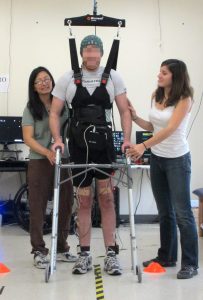What is surely a miracle in the life of a man who’s been paralyzed for five years was made possible by engineers at the University of California, Irvine.
The study was led by UCI biomedical engineer Zoran Nenadic and neurologist An Do, and resulted in a man with complete paralysis in both legs due to spinal cord injury was able to taking steps on his own, without relying on robotic limbs.
“Even after years of paralysis, the brain can still generate robust brain waves that can be harnessed to enable basic walking,” said Nenadic, an associate professor of biomedical engineering. “We showed that you can restore intuitive, brain-controlled walking after a complete spinal cord injury. This noninvasive system for leg muscle stimulation is a promising method and is an advance of our current brain-controlled systems that use virtual reality or a robotic exoskeleton.”

The participant was able to walk along a 12-foot course using an electroencephalogram-based system that lets the brain bypass the spinal cord to send messages to the legs. The system takes electrical signals from the brain, processes them through a computer algorithm, and then shoots them off to electrodes placed around the knees that trigger movement in the leg muscles.
To make it happen, the participant had to endure months of mental training in order to reactivate the brain’s walking ability, as well as physical therapy. He was asked to wear an EEG cap to read his brain waves. Then he was asked to think about moving his legs at which time brain waves were processed through a computer algorithm isolate those related to leg movement. He was later trained to control an avatar in a virtual reality environment, which validated the specific brain wave signals produced by the algorithm.
He spent time with the EEG cap on practicing walking while suspended 5 centimeters above the floor so he could freely move his legs without having to support himself, and then finally translated these skills to the ground, wearing a body-weight support system and pausing to prevent falls.
“Once we’ve confirmed the usability of this noninvasive system, we can look into invasive means, such as brain implants,” said Do, an assistant clinical professor of neurology. “We hope that an implant could achieve an even greater level of prosthesis control because brain waves are recorded with higher quality. In addition, such an implant could deliver sensation back to the brain, enabling the user to feel his legs.”

